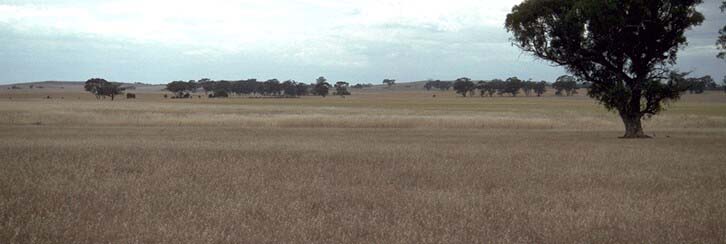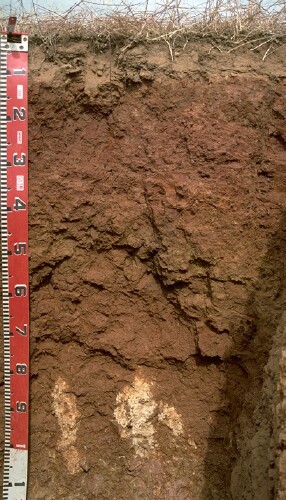Location: Mount Camel Landcare Group
Australian Soil Classification: Vertic (and Calcic), Mesonatric, Red SODOSOL
Northocte Factual Key: Dy 3.43
Great Soil Group: Red-Brown Earth
Site Description: Lower slope of a gently undulating rise (2% slope). Original vegetation included Grey Box (Eucalyptus microcarpa).
Geology: Ordovician Sediments

LP100 Landscape |
Soil Profile Morphology
Surface Soil
| A1 | 0-8 cm | Dark brown (7.5YR3/4) fine; sandy loam; hardsetting surface condition; weak coarse blocky structure; very firm consistence dry; contains a few (5-10%) mudstone and ironstone gravels (average size 5-10 mm); pH 6.2; sharp change to: |  LP100 Profile LP100 Profile |
| A2 | 8-15 cm | Yellowish red (5YR5/6) conspicuously bleached (5YR7/4d); fine sandy clay loam; massive; strong consistence dry; contains many (20%) ironstone, quartz and mudstone gravels; pH 6.6; abrupt and wavy change to: |
| Subsoil |
| B21 | 15-40 cm | Red (2.5YR4/7); medium clay; moderate medium blocky structure; strong consistence dry; pH 7.4; clear and wavy change to: |
| B22 | 40-60 cm | Yellowish red (5YR5/6); medium clay; moderate coarse prismatic, parting to moderate coarse blocky structure; very firm consistence moderately moist; pH 8.3; gradual change to: |
| B23 | 60-80 cm | Yellowish red (5YR5/8) with reddish yellow (7.5YR6/8) mottles; medium heavy clay; moderate coarse blocky structure; strong consistence moderately moist; many slickensides; pH 8.8; gradual change to: |
| B24k | 80-100 cm | Yellowish red (5YR5/6); medium clay; moderate medium polyhedral structure (smooth faced peds); contains a few (10%) fine-earth carbonates and semi-hard carbonates and many small dark flecks; strong consistence moderately moist; pH 8.9; clear change to: |
| B/C | 100 cm+ | Reddish yellow (7.5YR6/6) with red (2.5YR5/8) mottles; medium clay; strong medium polyhedral structure; very firm consistence moderately moist; contains 30% weathered mudstone and siltstone; pH 8.1. |
Key Profile Features
- Strong texture contrast between surface (A) horizons (< 20% clay) and subsoil (B21) horizon (57% clay).
- Coarsely structured, strongly sodic subsoil.
- Deeper subsoil has vertic properties and contains free carbonate (lime).
Key Profile Characteristics
 | pH | Salinity Rating | | |
Surface
(A1 horizon) | Slightly Acid | Very Low | Sodic | None1 |
Subsoil
(25-45 horizon) | Slightly Alkaline | Very Low | Strongly Sodic | Strong |
Deeper subsoil
( 80-100 cm) | Strongly Alkaline | Medium | Strongly Sodic | Slight |
| 1Moderate dispersion with remoulding |
Horizon | Horizon Depth
(cm) | pH
(water) | pH
(CaCl2) | EC
dS/m | NaCl | Organic Carbon
% | Total
Nitrogen
% | Exchangeable Cations | Coarse Sand
(0.2-2.0 mm)
% | Fine Sand
(0.02-0.2 mm)
% | Silt
(0.002-0.02 mm)
% | Clay
(<0.002 mm)
% | Field Capacity
% w/w | Wilting Point
% w/w |
Ca | Mg | K | Na |
meq/100g |
A1 | 0-8 | 6.2 | 4.9 | <0.05 |  | 1.3 | 0.13 | 2.3 | 0.96 | 0.67 | 0.24 | 19 | 55 | 13 | 11 | 17.8 | 4.9 |
A2 | 8-15 | 6.6 | 5.2 | <0.05 |  |  |  | 1.9 | 0.8 | 0.39 | 0.43 | 19 | 48 | 15 | 20 | 13.4 | 6.0 |
B21 | 15-40 | 7.4 | 6.1 | <0.05 |  |  |  | 4.2 | 6.6 | 0.0 | 2.8 | 9 | 25 | 10 | 57 |  |  |
B22 | 40-60 | 8.3 | 7.3 | <0.05 |  |  |  | 4.7 | 12 | 0.5 | 4.9 |  |  |  |  |  |  |
B23 | 60-80 | 8.8 | 8.1 | 0.00 |  |  |  | 12 | 15 | 1.4 | 7.4 |  |  |  |  |  |  |
B24k | 80-100 | 8.9 | 8.3 | 0.42 | 0.12 |  |  | 18 | 14 | 1.2 | 7.0 |  |  |  |  |  |  |
B/C | 100+ | 8.0 | 7.6 | 0.80 | 0.14 |  |  | 5 | 15 | 1.3 | 8.0 |  |  |  |  |  |  |
Management Considerations:
Whole Profile
- In general, management strategies for all soils should aim to increase organic matter levels in the surface soil; minimise the degradation of soil aggregates and porosity; promote the development of stable biopores; improve the calcium status of the ion exchange complex (particularly when sodium is a significant part – i.e. sodic), and break up any hardpans. Less frequent tillage; using less aggressive implements, and working the soil at optimum moisture conditions can all assist in maintaining soil aggregation and porosity as well as reducing the breakdown of organic matter. Practices such as residue retention, minimum tillage and including pasture rotations could be utilised if cropping takes place in order to build up organic matter, reduce erosion risk and increase fertility.
- Plant available water capacity (PAWC) is considered to be low (estimated at 75 mm). This is based on available laboratory data and assumes an effective rooting depth of 40 cm. Rooting depth will be restricted by the strongly sodic subsoil.
Surface (A) Horizons
- The surface soil is sodic and disperses moderately after remoulding. This indicates that dispersion may occur if the soil is cultivated or over-stocked whilst in a moist to wet condition. This could result in surface seal formation which would restrict seedling emergence and infiltration of water. Cultivating such a soil in a dry condition may also be deleterious to soil structure due to the high fine sand (55%) content. It is likely to become ‘powdery’ when cultivated dry, and subsequent rainfall may result in surface sealing occurring. Organic matter is important for maintaining aggregation on soils such as these. The organic matter level is relatively low at the soil pit site but may not be representative of the whole paddock. Organic matter will decrease if cropping takes place and should be improved by adopting residue retention, minimum tillage and pasture rotations. As well as improving aggregation, organic matter assists in increasing soil water holding capacity and fertility.
- The subsurface (A2) horizon is sodic and disperses strongly. This horizon becomes hard when dry and is likely to restrict plant root movement. Cultivation of this horizon should be avoided if it is in a moist to wet condition. Such disturbance is likely to result in a more restrictive cultivation pan developing.
Subsoil (B) Horizons
- The dense and coarsely structured upper subsoil is strongly sodic and disperses strongly. This is likely to result in restricted root and water movement through the subsoil. The high level of exchangeable magnesium relative to calcium is likely to reinforce the deleterious effects of exchangeable sodium on soil structure. Deep tillage with gypsum application has been advocated by some researchers as an ameliorative technique for sodic subsoils. However, deep tillage can be expensive and should not be carried out if the soil is wet, as subsoil structure will be damaged. If subsoil material is brought up to the soil surface then it should be treated with gypsum to prevent dispersion occurring.
- The dispersive subsoil will be highly erodible to water when exposed. Maintaining a protective cover of surface soil and vegetation is important, especially on sloping land.
- The high level of exchangeable sodium in the subsoil may also result in nutrient imbalances and may even have a toxic effect on some plants.
- The level of soluble salts becomes medium at 80 cm depth. This will restrict the growth of deeper rooted salt sensitive species.
- The deeper subsoil displays vertic properties (slickensides present from 60 cm depth). This indicates that significant shrinking and swelling occurs on wetting and drying. These properties may be of significance for engineering purposes (e.g. building foundations).
Comments from Landholder:
- Cropping occurred about 4-6 years ago.
- Superphosphate never applied.
Soil profile described by Mark Imhof, Paul Rampant and Karen DePlater (29/11/95). |

 LP100 Profile
LP100 Profile


